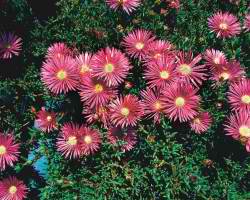Due to a unique combination of climate and terrain, California will always suffer from wildfires. But with appropriate planning, planting and maintenance, these fires won’t be devastating to homeowners.
A large portion of our state is a Mediterranean-type climate, situated in a region close to the sea with hot, dry summers, recurring winds and mountainous terrain. All of these characteristics help to create favorable conditions for fire.
If not stopped quickly, wildfires can ferociously destroy everything in their paths. It has been shown time and again that the proper selection of landscape plants and good maintenance will go a long way toward reducing fire danger. Second only to roof type, the plants surrounding a house have an enormous influence in determining a home’s survival during a wildfire.
“Vegetation will either lead a fire to a structure or stop it,” said fire-scaping expert and author Douglas Kent.
One of the greatest impacts a homeowner can have on protecting property and personal safety is to create and maintain a fire-resistant landscape. Planning ahead and consistent maintenance can help stop devastating property loss and even loss of life. With careful planning, a home garden or landscape can be both fire-resistant and water-wise.
As you make plant choices for fire-prone areas, you should remember that there is no such thing as a fireproof plant—only fire-resistant. Just about any plant will burn if temperatures get hot enough. Also, keep in mind that it takes about a year for plants (water-wise, fire-resistant or not) to become established. Only when well-established, are plants truly water-wise.
Here are valuable prevention steps to follow:
1. Understand which plants are fire-resistant. Research their fire retardant abilities as well as their drought tolerance.
2. Remove any dead, diseased or dying trees or shrubs.
3. Flammable trees and shrubs should be replaced even if they have adapted to require little water.
4. Keep brush and dried grass removed from the perimeter of your property so you have a firebreak.
5. Keep shrubs and trees thinned out. Dense brush leads to dead debris buildup and more fuel. Keep skirts removed from palms.
6. Keep irrigation systems in good working order and regularly check for adequate coverage. Do not stop watering. Water within the guidelines of your local municipality.
7. Keep your landscape in good condition.
A. Feed with organic fertilizers. This will reduce quick, soft growth that often results from high-nitrogen chemical fertilizers.
B. Keep plants free of pests and diseases, reducing damaged or dead growth.
C. Keep yards and gardens free of weeds.
8. Reduce thatch buildup (dead leaves and stems) on groundcovers like ivy and lantana. Mowing every two years will keep the dead material removed.
9. Keep roofs and gutters free of dead leaves and other debris.
As you plan your water-wise, fire-resistant garden, think in terms of four zones.* Each planting zone is designed around a particular purpose.
Zone 1 is the garden zone, the space next to your home outward to 30 feet. It is best to keep this space open. Plants in these areas will be the highest water users of your low-water palette, a typical practice of Mediterranean-climate gardens.
Moving away from your home from 30 to 70 feet, plants should be able to stop a ground fire. This is Zone 2. Plants chosen for this zone should reach a height of only 18 inches and be able to resist embers.
Zone 3 is a transition zone and is designed to slow fires. It is approximately 71 to 120 feet from the house. It is composed of drought-tolerant plants and is typically unwatered once established. It might be comprised of, for instance, a barrier planting of shrubs such as rockrose that can survive on rainwater.
For residents whose gardens adjoin foothills or natural, open spaces, these natural areas comprise Zone 4. If your home and garden is surrounded by other homes, you won’t have a Zone 4.
Zone summary
1. Garden Zone – 30 feet around house. Plants need to withstand embers. Simple designs, large open spaces so firefighters can move around freely. Landscape should be watered and kept green.
2. Fuel Break – 31 to 70 feet from house. Must be able to stop a ground fire. No plants over 18-inches high. Plants must withstand fire.
3. Transition Zone – 71 to 120 feet from house. Un-watered. This zone should slow the fire. A barrier planting of shrubs such as rockrose that can survive on rainwater.
4. Natural Zone – Remove natural vegetation regularly. You will not have this zone if your home is not bordered by foothills or other open, natural areas.
Jones is the Chief Horticulturist at Armstrong Garden Centers. Email your gardening questions to him via growingdialogue@armstronggarden.com or contact your local Armstrong Garden Centers location.















